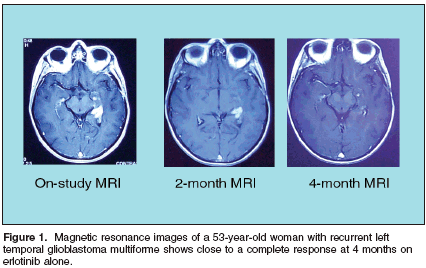Erlotinib Demonstrates Objective Response Against Malignant Gliomas in Phase I Data
This special supplement toOncology News International presents11 reports on novel agents targetingHER1/EGFR, VEGF, and HER2/neu receptorsin the treatment of non–small-cell lung cancer,colorectal cancer, mesothelioma, andglioblastoma. The reports summarizeselected presentations from theAmerican Society of Clinical Oncology (ASCO)39th Annual Meeting and a satellitesymposium held in conjunction with ASCO.
CHICAGO-Preliminary resultsfrom a phase I study of erlotinib(OSI-774,Tarceva) have shown a 16%response rate in malignant glioma patients,triggering plans for phase IIstudies of the novel agent alone and incombination with other therapies.Michael D. Prados, MD, of theBrain Tumor Research Program at theUniversity of California, San Francisco,reported the data at ASCO (ASCOabstract 394) and at a post-ASCO,industry-sponsored, satellite symposium,"Targeting Critical Pathways inOncology."Dr. Prados told ONI that the resultsexceeded expectations in one ofthe first trials to test erlotinib againstgliomas. "I was very surprised, veryhappily surprised, that we actually sawobjective response in patients using asingle oral agent. I think that's quiteunusual," he said.

A small molecule, erlotinib inhibitsthe HER1/epidermal growth factorreceptor (HER1/EGFR) tyrosine kinase,which is often amplified in gliomas.Erlotinib is being developed byGenentech, Inc., and OSI Pharmaceuticals,Inc.All patients in the trial must havehistologically proven malignant gliomaand a Karnofsky performance score≥ 60, but EGFR tumor status is not acriterion for enrollment.The ongoing study is testing erlotinibalone and in combination withtemozolomide (Temodar), a commontreatment for brain tumors. Of 66 patientsenrolled so far, 49 were evaluableat the time of the report. Seven ofthe eight patients who responded hadglioblastoma multiforme, and six hadreceived erlotinib alone.

Close to A Complete Response
Magnetic resonance images (MRIs)of a 55-year-old woman showed howshe experienced close to a completeresponse at 4 months on erlotinib alone(see Figure 1). MRIs also demonstrateda partial response from a 50-yearoldman with recurrent glioblastoma,who was taking 400 mg of erlotinibdaily. Dr. Prados said the man hascontinued on the study for almost 11months despite a rash at that dose."It's rare to see responses in phaseI. It's rare to see responses in glioblastomaeven with the best drugs, and itwas unanticipated in this because weweren't certain about all the pharmokinetics,"Dr. Prados said.Investigators also subdivided botharms of the trial to assess the impact ofenzyme-inducing antiepileptic drugs(EIAEDs), which some patients taketo prevent seizures. The trial started at100 mg/day of erlotinib, with the doseescalating by 50 mg/day for eachcohort. Temozolomide was given in28-day cycles, the dose starting at150 mg/m2 for 5 days and escalating to200 mg in cycle 2 with no furtherincreases (see Table 1).For patients not on EIAIDs, doselimitingtoxicity was reached at250 mg of erlotinib in both arms. Forpatients on EIAIDs, the maximum tolerateddose has not been reached. Investigatorsare currently at a dose of500 mg of erlotinib alone, or 350 mg oferlotinib with temozolomide and arestill escalating the dose in patients onEIAIDs who are receiving both erlotiniband temozolomide."Clearly use of EIAEDs reduces responseto the agent," Dr. Prados said,noting that 500 mg is almost four timesthe recommended dose.Rash was the primary dose-limitingtoxicity, according to Dr. Prados.At a later ASCO session, Gary M. Clark,PhD, of OSI Pharmaceuticals presentedan analysis that found rash correlatedwith response and survival inprior erlotinib trials. (See article inthis supplement, page 1.) At the post-ASCO symposium, Dr. Prados saidgrades 1 and 2 rashes were common inthe glioma study, but his group hasnot yet done a correlation.Survival Data Pending
As the phase I trial continues toenroll patients, Dr. Prados said estimationof progression-free survival isstill pending. Meanwhile, he announcedplans for phase II trials oferlotinib in combination with radiationtherapy in new glioma patientsand by itself in relapsed patients."There's going to have to be somecombination strategy," Dr. Pradosconcluded. "It's a well-tolerated oraldrug that has exciting, early, objectivebiological activity."